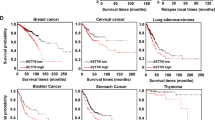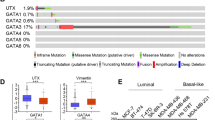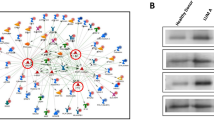Abstract
Basal-like breast cancers (BLBCs) are aggressive tumors with high relapse rates and poor survival. We recently reported that >70% of primary BLBCs express the oncogenic transcription/translation factor Y-box binding protein-1 (YB-1) and silencing it with small interfering RNAs (siRNAs) attenuates the growth of BLBC cell lines. To understand the basis of these earlier findings, we profiled YB-1:DNA complexes by chromatin immunoprecipitation (ChIP)-on-chip. Several tumor growth-promoting genes such as MET, CD44, CD49f, WNT and NOTCH family members were identified. In addition, YB-1 and MET are coordinately expressed in BLBC cell lines, as well as in normal human mammary progenitor cells. MET was confirmed to be a YB-1 target through traditional ChIP and gel-shift assays. More specifically, YB-1 binds to −1018 bp on the MET promoter. Silencing YB-1 with siRNA decreased MET promoter activity, transcripts, as well as protein levels and signaling. Conversely, expressing wild-type YB-1 or a constitutively active mutant YB-1 (D102) increased MET expression. Finally, silencing YB-1 or MET attenuated anchorage-independent growth of BLBC cell lines. Together, these findings implicate MET as a target of YB-1 that work in concert to promote BLBC growth.
This is a preview of subscription content, access via your institution
Access options
Subscribe to this journal
Receive 50 print issues and online access
$259.00 per year
only $5.18 per issue
Buy this article
- Purchase on Springer Link
- Instant access to full article PDF
Prices may be subject to local taxes which are calculated during checkout





Similar content being viewed by others
Abbreviations
- BLBC:
-
basal-like breast cancer
- ChIP:
-
chromatin immunoprecipitation
- COC:
-
ChIP-on-chip
- CST:
-
Cell Signaling Technologies
- EMSA:
-
electrophoretic mobility shift assay
- HGF:
-
hepatocyte growth factor
- siRNA:
-
small interfering RNA
- PBS:
-
phosphate-buffered saline
- YB-1:
-
Y-box binding protein-1
References
Al-Hajj M, Wicha MS, Benito-Hernandez A, Morrison SJ, Clarke MF . (2003). Prospective identification of tumorigenic breast cancer cells. Proc Nat Acad Sci USA 100: 3983–3988.
Birchmeier C, Birchmeier W, Gherardi E, Vande Woude GF . (2003). Met, metastasis, motility and more. Nat Rev Mol Cell Biol 4: 915–925.
Boccaccio C, Comoglio PM . (2006). Invasive growth: a MET-driven genetic programme for cancer and stem cells. Nat Rev Cancer 6: 637–645.
Boon EMJ, van der Neut R, van de Wetering M, Clevers H, Pals ST . (2002). Wnt signaling regulates the receptor tyrosine kinase Met in colorectal cancer. Cancer Res 62: 5126–5128.
Charafe-Jauffret E, Ginestier C, Monville F, Finetti P, Adelaide J, Cervera N et al. (2006). Gene expression profiling of breast cell lines identifies potential new basal markers. Oncogene 25: 2273–2284.
Colozza M, de Azambuja E, Personeni N, Lebrun F, Piccart MJ, Cardoso F . (2007). Achievements in systemic therapies in the pregenomic era in metastatic breast cancer. Oncologist 12: 253–270.
Comoglio PM, Giordano S, Trusolino L . (2008). Drug development of MET inhibitors: targeting oncogene addiction and expedience. Nat Rev Drug Discov 7: 504–516.
Dontu G, Jackson KW, McNicholas E, Kawamura MJ, Abdallah WM, Wicha MS . (2004). Role of Notch signaling in cell-fate determination of human mammary stem/progenitor cells. Breast Cancer Res 6: R605–R615.
Dunn BK, Ford LG . (2007). Hormonal interventions to prevent hormonal cancers: breast and prostate cancers. Eur J Cancer Prev 16: 232–242.
Eirew P, Stingl J, Raouf A, Turashvili G, Aparicio S, Emerman JT et al. (2008). A method for quantifying normal human mammary epithelial stem cells with in vivo regenerative ability. Nat Med 14: 1384–1389. Published online, 23 November.
Farnie G, Clarke RB, Spence K, Pinnock N, Brennan K, Anderson NG et al. (2007). Novel cell culture technique for primary ductal carcinoma in situ: role of Notch and epidermal growth factor receptor signaling pathways. J Natl Cancer Inst 99: 616–627.
Gambarotta G, Boccaccio C, Giordano S, Ando M, Stella MC, Comoglio PM . (1996). Ets up-regulates MET transcription. Oncogene 13: 1911–1917.
Habibi G, Leung S, Law JH, Gelmon K, Masoudi H, Turbin D et al. (2008). Redefining prognostic factors for breast cancer: YB-1 is a stronger predictor of relapse and disease-specific survival than estrogen receptor or HER-2 across all tumor subtypes. Breast Cancer Res 10: R86.
Kuwano M, Oda Y, Izumi H, Yang S, Uchiumi T, Iwamoto Y et al. (2004). The role of nuclear Y-box binding protein-1 as a global marker of drug resistance. Mol Cancer Ther 3: 1485–1492.
Lee C, Dhillon J, Wang MY, Gao Y, Hu K, Park E et al. (2008). Targeting YB-1 in HER-2 overexpressing breast cancer cells induces apoptosis via the mTOR/STAT3 pathway and suppresses tumor growth in mice. Cancer Res 68: 8661–8666.
Leo C, Horn LC, Einenkel J, Hentschel B, Hockel M . (2007). Tumor hypoxia and expression of c-met in cervical cancer. Gynecol Oncol 104: 181–185.
Mani SA, Guo W, Liao M, Eaton E, Ayyanan A, Ahaou AY et al. (2008). The epithelial-mesenchymal transition generates cells with properties of stem cells. Cell 133: 704–715.
Okamoto T, Izumi H, Imamura T, Takano H, Ise T, Uchiumi T et al. (2000). Direct interaction of p53 with the Y-box binding protein, YB-1: a mechanism for regulation of human gene expression. Oncogene 19: 6194–6202.
Orian-Rousseau V, Chen L, Sleeman JP, Herrlich P, Ponta H . (2002). CD44 is required for two consecutive steps in HGF/c-Met signaling. Genes Dev 16: 3074–3086.
Pennacchietti S, Michieli P, Galluzzo M, Mazzone M, Giordano S, Comoglio PM . (2003). Hypoxia promotes invasive growth by transcriptional activation of the met protooncogene. Cancer Cell 3: 347–361.
Raouf A, Zhao Y, To K, Stingl J, Delaney A, Barbara M et al. (2008). Transcriptome analysis of the normal human mammary cell commitment and differentiation process. Cell Stem Cell 3: 109–118.
Sachs M, Brohmann H, Zechner D, Muller T, Hulsken J, Walther I et al. (2000). Essential role of Gab1 for signaling by the c-met receptor in vivo. J Cell Bio 150: 1375–1384.
Shadeo A, Lam WL . (2006). Comprehensive copy number profiles of breast cancer cell model genomes. Breast Cancer Res 8: R9.
Shipitsin M, Campbell LL, Argani P, Weremosicz S, Bloushtain-Qimorn N, Yao J et al. (2007). Molecular definition of breast tumor heterogeneity. Cancer Cell 11: 259–273.
Sorlie T, Perou CM, Tibshirani R, Aas T, Geisler S, Johnsen H et al. (2001). Gene expression patterns of breast carcinomas distinguish tumor subclasses with clinical implications. Proc Natl Acad Sci USA 98: 10869–10874.
Stingl J, Eirew P, Ricketson I, Shackleton M, Vaillant F, Choi D et al. (2006). Purification and unique properties of mammary epithelial stem cells. Nature 439: 993–997.
Stratford AL, Fry CJ, Desilets C, Davies AH, Cho YY, Li Y et al. (2008). Y-box binding protein-1 (YB-1) serine 102 is a downstream target of p90 ribosomal S6 kinase (RSK) in basal-like breast cancer cells. Breast Cancer Res 10: R99: (e-pub ahead of print).
Stratford AL, Habibi G, Astanehe A, Jiang H, Hu K, Park E et al. (2007). Epidermal growth factor receptor (EGFR) is transcriptionally induced by the Y-box binding protein-1 (YB-1) and can be inhibited with Iressa in basal-like breast cancer, providing a potential target for therapy. Breast Cancer Res 9: R61.
Sutherland BW, Kucab JE, Wu J, Lee C, Cheang MCU, Yorida E et al. (2005). Akt phosphorylates the Y-box binding protein-1 at Ser102 located in the cold shock domain and affects the anchorage-independent growth of breast cancer cells. Oncogene 24: 4281–4292.
To K, Zhao Y, Jiang H, Hu K, Wang M, Wu J et al. (2007). The phosphoinositide-dependent kinase-1 inhibitor 2-amino-n-[4-[5-(2-phenanthrenyl)-3-(trifluoromethyl)-1H-pyrazol-1-yl] phenyl]-acetamide (OSU-03012) prevents Y-box binding protein from inducing epidermal growth factor receptor. Mol Pharm 72: 641–652.
Trusolino L, Bertotti A, Comoglio PM . (2001). A signaling adapter function for alpha6beta4 integrin in the control of HGF-dependent invasive growth. Cell 107: 643–654.
Trusolino L, Comoglio PM . (2002). Scatter-factor and semaphorin receptors: cell signalling for invasive growth. Nat Rev Cancer 2: 289–300.
van Roeyen CR, Eitner F, Martinkus S, Thieltges SR, Ostendorf T, Bokemeyer D et al. (2005). Y-box protein mediates PDGF-B effects on mesangioproliferative glomerular disease. J Am Soc Nephrol 16: 2985–2996.
Welm AL, Kim S, Welm BE, Bishop JM . (2005). MET and MYC cooperate in mammary tumorigenesis. Proc Natl Acad Sci USA 102: 4324–4329.
Wu J, Lee C, Yokom D, Jiang H, Cheang MC, Yorida E et al. (2006). Disruption of the Y-box binding protein-1 results in suppression of the epidermal growth factor receptor and HER-2. Cancer Res 66: 4872–4879.
Yoshida S, Harada T, Mitsunari M, Iwabe T, Sakamoto Y, Tsukihara S et al. (2004). Hepatocyte growth factor/Met system promotes endometrial and endometriotic stromal cell invasion via autocrine and paracrine pathways. J Clin Endocrinol Metab 89: 823–832.
Zhao Y, Raouf A, Kent D, Khattra J, Delaney A, Schenerch A et al. (2007). A modified polymerase chain reaction-long serial analysis of gene expression protocol identifies novel therapeutics in human CD34+ bone marrow cells. Stem Cells 25: 1681–1689.
Acknowledgements
This project was funded by the Canadian Breast Cancer Research Alliance (awarded to SED) and the National Institute of Health (RO1 awarded to SED). A Astanehe, K To and A Davies are recipients of Michael Smith Foundation for Health Research Graduate Studentships. A Astanehe and K To are recipients of Canadian Institute for Health Graduate Studentships. A Stratford holds a Canadian Breast Cancer Foundation Postdoctoral Fellowship. P Eirew is the recipient of the US Department of Defense Breast Cancer Research Program Studentship, the Terry Fox Foundation Research Studentship from the National Cancer Institute of Canada, the Canadian Imperial Bank of Commerce Interdisciplinary Award and the Canadian Stem Cell Network Studentship.
Author information
Authors and Affiliations
Corresponding author
Additional information
Supplementary Information accompanies the paper on the Oncogene website (http://www.nature.com/onc).
Rights and permissions
About this article
Cite this article
Finkbeiner, M., Astanehe, A., To, K. et al. Profiling YB-1 target genes uncovers a new mechanism for MET receptor regulation in normal and malignant human mammary cells. Oncogene 28, 1421–1431 (2009). https://doi.org/10.1038/onc.2008.485
Received:
Revised:
Accepted:
Published:
Issue Date:
DOI: https://doi.org/10.1038/onc.2008.485
Keywords
This article is cited by
-
Circular RNA cFAM210A, degradable by HBx, inhibits HCC tumorigenesis by suppressing YBX1 transactivation
Experimental & Molecular Medicine (2023)
-
Known and novel roles of the MET oncogene in cancer: a coherent approach to targeted therapy
Nature Reviews Cancer (2018)
-
Uncoupling of EGFR–RAS signaling and nuclear localization of YBX1 in colorectal cancer
Oncogenesis (2016)
-
YB-1 is elevated in medulloblastoma and drives proliferation in Sonic hedgehog-dependent cerebellar granule neuron progenitor cells and medulloblastoma cells
Oncogene (2016)
-
YB-1 regulates Sox2 to coordinately sustain stemness and tumorigenic properties in a phenotypically distinct subset of breast cancer cells
BMC Cancer (2014)



